I knew Pied-billed Grebes were thieves but until yesterday I had no idea how incredibly sneaky their thievery can be. They’re notorious and highly skilled kleptoparasites (food-stealers) but this particular bird has refined the art of theft to the point of mastery and beyond.
Yesterday afternoon I paid a rare afternoon visit to Farmington Bay WMA (usually I’m there in the mornings). Birds were slow but I was able to document a behavior that was completely new to me and after 10 years of photographing and observing bird behaviors that’s something that rarely happens anymore.
For the following reasons the photos are only of mediocre quality but I think they document the behavior well enough:
- the afternoon light was harsh
- I was shooting from the bridge at the 4-way so the shooting angle was steep
- I was too close to the grebes so depth of field was extremely limited and overall sharpness is an issue
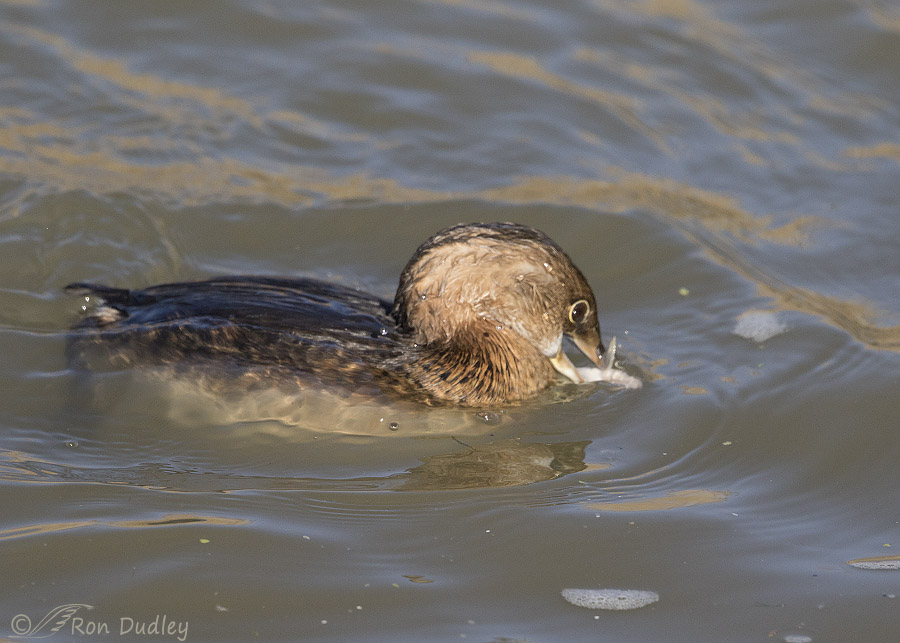
1/3200, f/6.3, ISO 800, Canon 7D Mark II, Canon EF 500mm f/4L IS II USM + EF 1.4 III Extender, not baited, set up or called in
At such a steep angle I normally wouldn’t even aim my lens at a bird but when this grebe caught a fish my instincts kicked in and I fired off a quick burst of 7 photos (lasting .7 sec.).
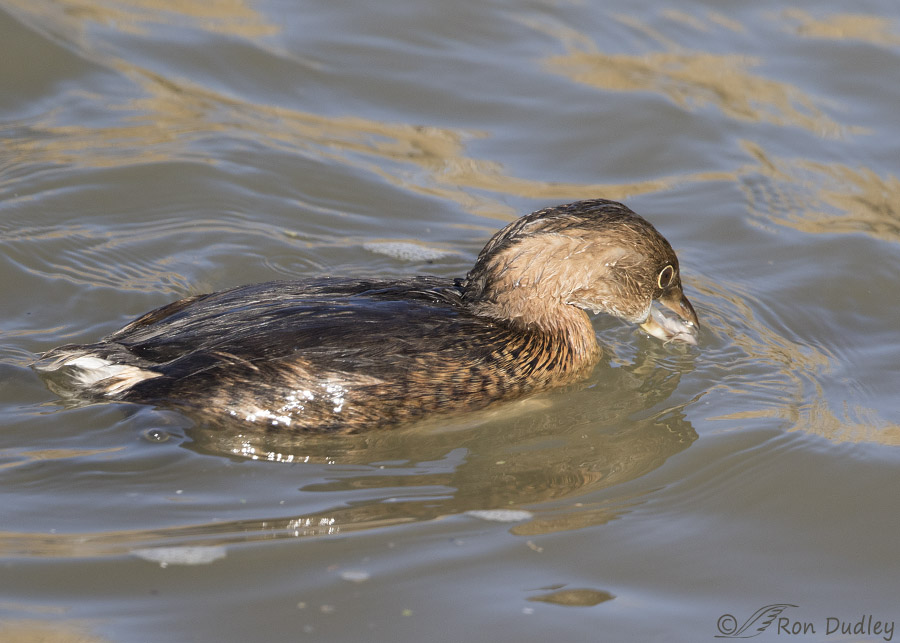
1/2000, f/6.3, ISO 800, Canon 7D Mark II, Canon EF 500mm f/4L IS II USM + EF 1.4 III Extender, not baited, set up or called in
For the first two images in the burst the grebe was still pinching and crushing the fish with its powerful bill to make sure it was disabled or dead before swallowing it head first. In these first three shots we can’t see much of the fish but it’s larger than it appears to be.
1/2500, f/6.3, ISO 800, Canon 7D Mark II, Canon EF 500mm f/4L IS II USM + EF 1.4 III Extender, not baited, set up or called
Suddenly from out of nowhere appeared the creature from the black lagoon – another grebe intent on stealing the fish. From elsewhere on the pond the second grebe had seen the first one with the fish and then dived for a sneak-attack from the depths.
I’m sure the grebe with the fish had no idea the second one was coming (and of course neither did I). I just happened to snap my shutter when it first became visible and before either bird could react to the situation. Though we can’t see much of the fish (only its head) the pilfering grebe appears to be in perfect position to clamp its beak on the tail of the fish.
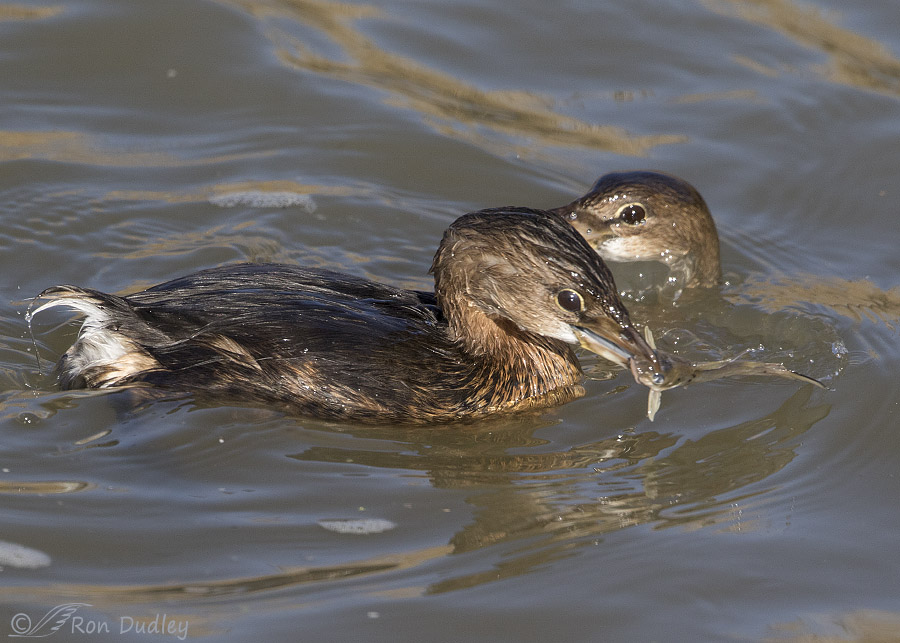
1/3200, f/6.3, ISO 800, Canon 7D Mark II, Canon EF 500mm f/4L IS II USM + EF 1.4 III Extender, not baited, set up or called
But the rightful owner of the fish jerked it away just in time to prevent the theft…
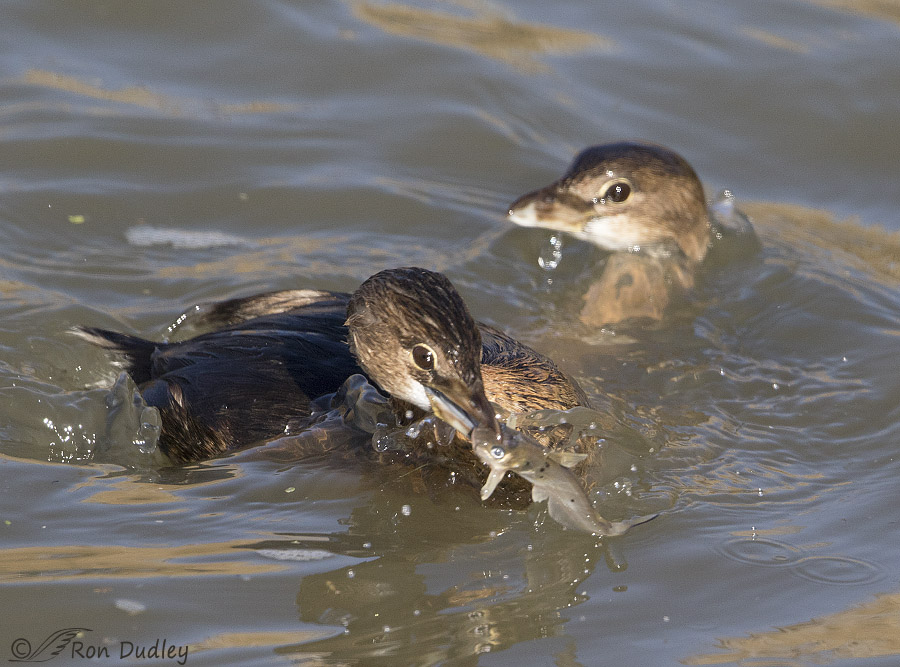
1/3200, f/6.3, ISO 800, Canon 7D Mark II, Canon EF 500mm f/4L IS II USM + EF 1.4 III Extender, not baited, set up or called
and get the hell out of Dodge with it…
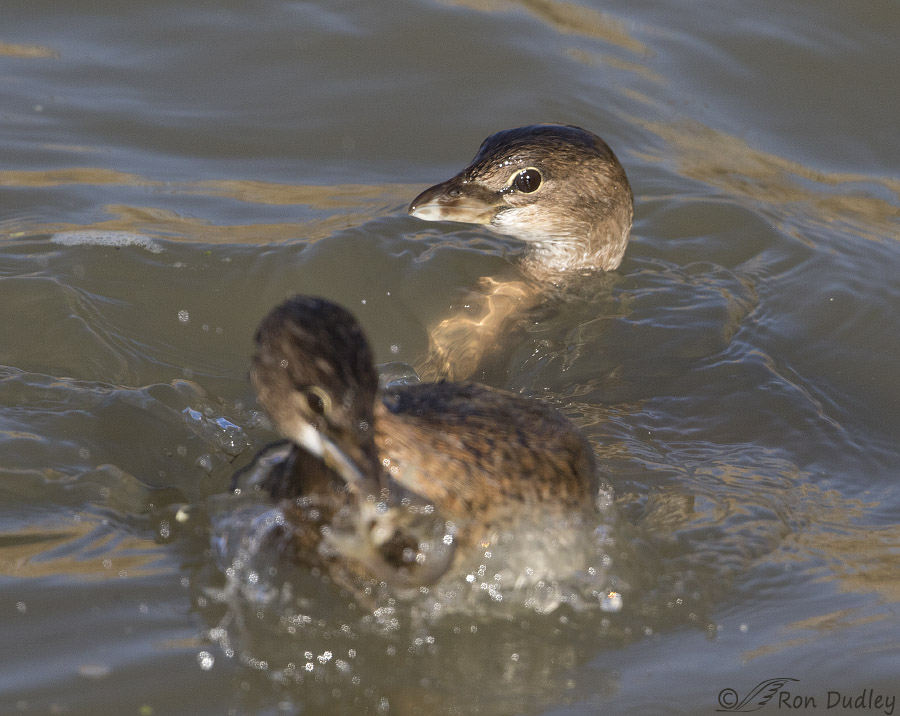
1/3200, f/6.3, ISO 800, Canon 7D Mark II, Canon EF 500mm f/4L IS II USM + EF 1.4 III Extender, not baited, set up or called
which left the potential thief behind to ponder what happened to its intended meal.
At this point the wannabe thief gave up and the first grebe swam away and swallowed the fish but not before…
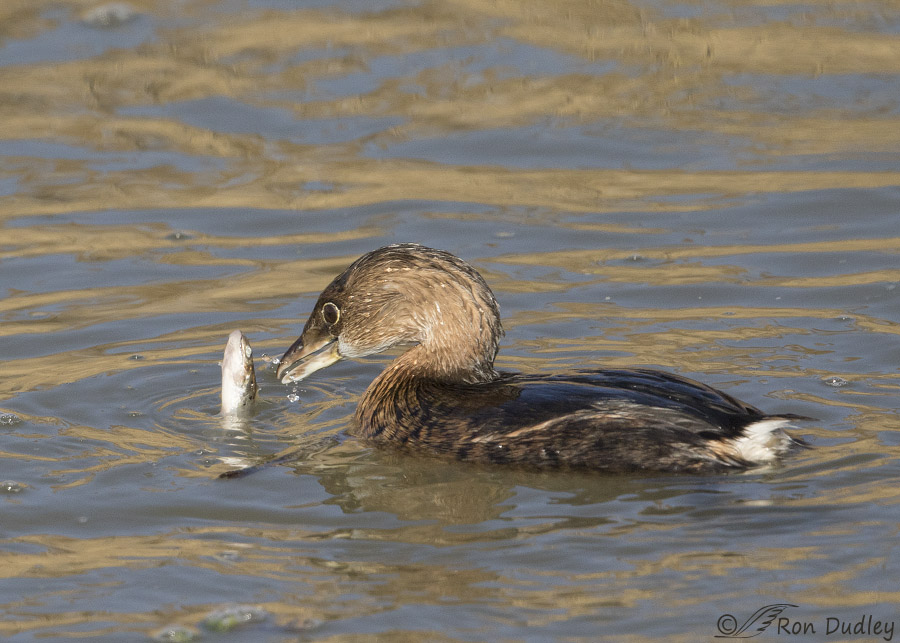
1/4000, f/6.3, ISO 800, Canon 7D Mark II, Canon EF 500mm f/4L IS II USM + EF 1.4 III Extender, not baited, set up or called
the now deceased fish performed a vertical tail-stand in the water as its swan song.
I can’t even begin to tell you how surprised I was by this behavior, especially considering the fact that I didn’t even know it had occurred until I arrived home and looked at the photos on my computer screen. This flurry of activity happened so incredibly fast that (believe it or not) I didn’t even know there was a second grebe involved until I arrived home. Photographers know that when the camera shutter moves across our screen our view of the action is blocked for an instant so that didn’t help but I was still dumbfounded that I had missed so much of what really went down.
Have I ever mentioned that I love bird behaviors?
Ron
Note: I had another surprise with this encounter. Over the years I’ve photographed many hundreds of fish being captured and eaten by birds at Farmington and in the past every one of those fish appeared to be either a young carp or a weather loach. But to my eye this fish doesn’t appear to be either a carp or a loach. It may be a catfish but since I’m no ichthyologist I’m not sure what it is.
There’s always something new “out there” if you pay attention…


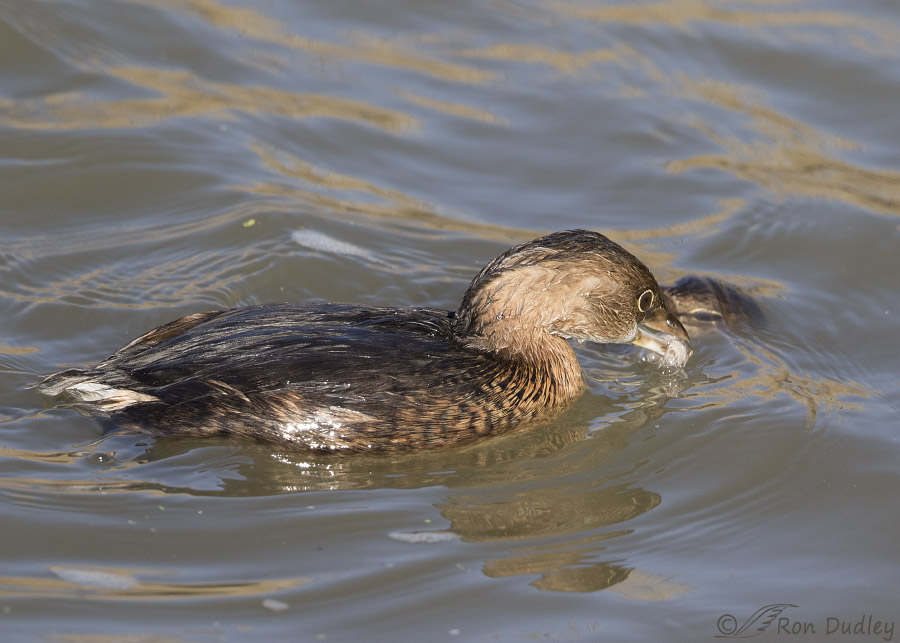
Excellent action shots and great timing, even if it was by accident!
Thanks for sharing! I’ve learned a new behavior too. Love your photos on all blogs by the way.
Terrific series, Ron, and an excellent example of why I like to photograph birds even in not-so-great conditions. I always see more in my photos than I saw at the time. Those who say photography is not the way to learn birds just never had a camera ( or never used it).
“Those who say photography is not the way to learn birds just never had a camera ( or never used it)”
Boy, you’ve got that right, Nancy. Exactly right. With an exclamation point!
From now on Pied-billed Grebes will always be known by me as Mr.& Mrs. Sneak or Crafty Sneak. I knew they would try and steal, but an underwater frontal attack never had the idea until now! Great behavioral shots Ron! Been snowing hard here since 0600, thank the good lord it is only powder. Have, so far, about 10 inches. Because of family obligations (grandkid jobs, etc.,) we’ll have Xmas with half tomorrow and the other half on Sunday. Just hope the freezing rain stays south.
Great shooting in 18′ and a Merry Christmas and Happy New Year to both you and Mia.
Dick, I’ve read several times in the past that one of their favorite modes of attack is underwater but those sources (BNA among them) never mentioned them doing it with kleptoparasitism in mind so I never even considered the possibility. Silly me. I should have known…
Nope, just means your human like the rest of us!! LOL!!
Yep, embrace your (comparative) dullard self and then you can delight in the magic when you find it.
What an incredibly sneaky thing to do. I suspect that the sneak grebe has learned it is often a successful tactic too. Great series, and I am so very glad that your camera was quicker than your eye.
Who knows, EC – maybe the sneaky one learned the tactic from the victim in this case.
Oh just WOW!! What a glorious series, picky little photographic technical details be damned!

Have I mentioned that I just love (and we’re talking LOVE!!!) your behavioral images/series? I SERIOUSLY love seeing things that birds/critters do when we’re not looking/seeing/hearing. It excites my soul. Plus, there’s that thing that humans are so darn slow that we miss so much of what we “see.” We THINK we know it all, and then, yeah, NO! I think there’s always something new to learn if you keep your mind open and your mouth shut–and if we limit ourselves to just that one thing a day (or like some folks, no things because they already know it all), we’re gonna miss a lot of the magic this world has to offer. Thanks to you, I’m up somewhere in late November 2073 in my learning new things every day agenda!
The thieving grebe has really elevated thievery style to an art form. S/he has been doing this for a while, mastering all the little details and nuances of her/his art. That sneak attack was brilliant in terms of the daily food-acquisition task and boy do I respect that! However, being a raptorphile and all, I respect mastering the art of catching your own a little more. But that’s just me. There’s ALWAYS the possibility (probability) that I’m wrong…LOL!
I’m no ichthyologist, either (or any kind of -ologist for that matter), but it looks like a catfish (or a close relative) to me. But what do I know?
Thank you, Laura. If sneaky works for them it works for me!
Ron, a great series of Grebes and how sneaky and fast they can be. I was glad that the rightful owner kept the prey and was able to consume the catch.
And then a few minutes later the “rightful owner” becomes the thief, Alice. To coin a phrase, what comes around goes around.
I realize that kleptoparasitism is a fact/way of life for some creatures, but I’m happy that the guy who did all the work was able to keep his fish. This is a great series of photos, even if the quality isn’t the greatest. At least for me, it’s the capturing of the behavior that is important. And I couldn’t agree with you more that there is always something new to be seen out there. I’ve learned to keep my eyes open and looking, and even when what I see is just a small thing, it’s still exciting to see the new behavior, creature, plant, etc.
“it’s the capturing of the behavior that is important”
Agreed, Susan. Thank you.
Sneaky! Sneaky! Such a great series, Ron!
Such a great series, Ron!
Thank you, Marty.
Can’t wait to get out again .. but busy busy getting ready for Christmas .. love those sneaky grebes .. plus the mergansers are terrible theives too!! I see grebes with fish running over top of water with mergansers in hot pursuit..
Thanks, Marina.
The thing I love most about bird photography is that we get to see things that most of us just dont have the visual acuity to be sure of without the camera. This is a great example. Live and without a camera, even with binoculars, I would have had no idea what happened there. It is a fascinating glimpse into a world from which we are mostly excluded. Catch & Release hunting at its finest! Thanks for sharing.
“Catch & Release hunting at its finest”
Believe me, it wasn’t “released” for long, Porcupine!
I agree with you about the ability of photography to reveal those little details our naked eyes so often miss.
OMG—-what a capture ! This is the week for musical themes to accompany your photos : for this one, it was the shark attack from “Jaws”, as the shark suddenly leaps from the depths !
Well, I’ll be “enjoying” that earworm all morning now, Kris. Thanks!
In the best picture of the fish it looks like a cat of some sorts to me…. What a GREAT capture technical perfection be damned! Obviously the would be the thief has had practice at it……… Amazing that the “owner” of the fish could react fast enough to prevent the theft. It is always interesting what turns up in a photo that we didn’t realize was there when we too the shot.
Obviously the would be the thief has had practice at it……… Amazing that the “owner” of the fish could react fast enough to prevent the theft. It is always interesting what turns up in a photo that we didn’t realize was there when we too the shot.  More snow – a pain, BUT!
More snow – a pain, BUT!
“Amazing that the “owner” of the fish could react fast enough to prevent the theft”
Judy, It’s my belief that Pied-billed Grebes are the fastest water birds I’ve EVER photographed – in almost everything they do. Their speed is nothing short of mind-blowing. As a biologist I even have to wonder how their nerves and muscles can react as fast as they do.
And yes, I believe the fish is likely a catfish but I’m not sure.
It looks a lot like a baby Channel Catfish.
I think it might be too, David. In fact just a few minutes ago I edited my text to mention that possibility.